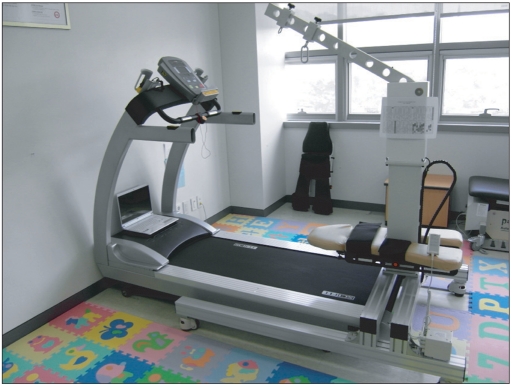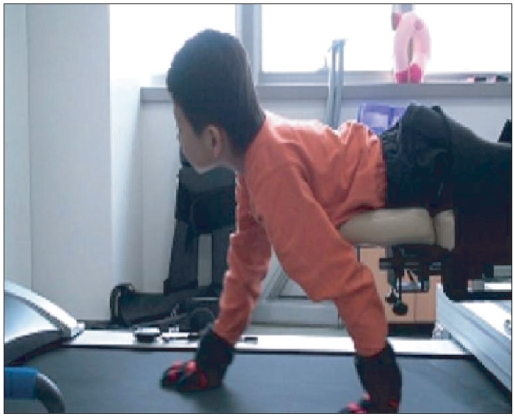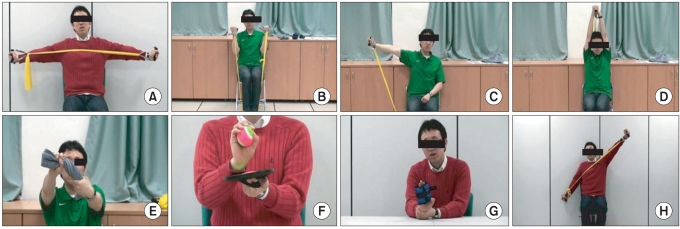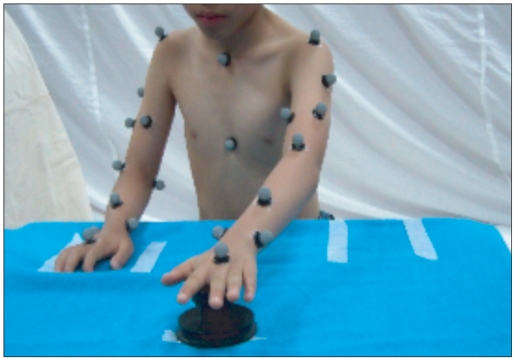Ann Rehabil Med.
2012 Feb;36(1):39-46. 10.5535/arm.2012.36.1.39.
The Effect of Comprehensive Hand Repetitive Intensive Strength Training (CHRIST) Using Motion Analysis in Children with Cerebral Palsy
- Affiliations
-
- 1Department of Rehabilitation Medicine, National Rehabilitation Hospital, Seoul 142-884, Korea. jjpark0324@gmail.com
- 2Department of Motor & Cognitive Rehabilitation, Korea National Rehabilitation Research Institute, Seoul 142-884, Korea.
- 3Department of Physical Therapy, Yonsei University, Wonju 220-710, Korea.
- KMID: 2266779
- DOI: http://doi.org/10.5535/arm.2012.36.1.39
Abstract
OBJECTIVE
To investigate the effect of Comprehensive Hand Repetitive Intensive Strength Training (CHRIST) on upper limb function in children with cerebral palsy using motion analysis. METHOD: The subjects in this study included 19 children (10 males, 9 females, mean age=8.8 years) with cerebral palsy. The experimental group (n=10) received CHRIST and general rehabilitation therapy. The control group (n=9) received a home program as well as general rehabilitation therapy. Both groups received 30 sessions of CHRIST or home program training for 60 minutes per session 3 times a week during the 10-week period. The reaching movements were captured by a motion analysis system. Kinematic variables including movement time (MT), mean velocity (MV), normalized jerk score (NJS), mean angular velocity (MAV) and normalized jerk score of the shoulder, elbow and wrist joint with comfortable and fast speed were analyzed between groups and the pre-post training group.
RESULTS
After pre- and post-training experimental group, MT, MV, NJS, MAV of shoulder, elbow, wrist and NJS of elbow and wrist improved significantlyin reaching movement of both comfortable and fast speed (p<0.05). However, After pre- and post-training control group, MV improved significantlyin reaching movement of only comfortable speed (p<0.05). Between two groups, MT and MAV of the elbow at comfortable speed and NJS of the elbow at fast speed were statisticallysignificant (p<0.05).
CONCLUSION
CHRIST proved to be an effective intervention for improving upper limb extremity function of reaching movement in children with cerebral palsy.
Keyword
MeSH Terms
Figure
Reference
-
1. Bax M, Goldstein M, Rosenbaum P, Leviton A, Paneth N, Dan B, Jacobsson B, Damiano D. Proposed definition and classification of cerebral palsy, April 2005. Dev Med Child Neurol. 2005; 47:571–576. PMID: 16108461.
Article2. Ketelaar M, Vermeer A, Hart H, van Petegem-van Beek E, Helders PJ. Effects of a functional therapy program on motor abilities of children with cerebral palsy. Phys Ther. 2001; 81:1534–1545. PMID: 11688590.
Article3. Boyd RN, Morris ME, Graham HK. Management of upper limb dysfunction in children with cerebral palsy: a systematic review. Eur J Neurol. 2001; 8(Suppl 5):150–166. PMID: 11851744.
Article4. Taub E, Ramey SL, DeLuca S, Echols K. Efficacy of constraint-induced movement therapy for children with cerebral palsy with asymmetric motor impairment. Pediatrics. 2004; 113:305–312. PMID: 14754942.
Article5. Damiano DL, Dodd K, Taylor NF. Should we be testing and training muscle strength in cerebral palsy? Dev Med Child Neurol. 2002; 44:68–72. PMID: 11811654.
Article6. Dodd KJ, Taylor NF, Damiano DL. A systematic review of the effectiveness of strength-training programs for people with cerebral palsy. Arch Phys Med Rehabil. 2002; 83:1157–1164. PMID: 12161840.
Article7. Lee DR, You JH, Lee NG, Oh JH, Cha YJ. Comprehensive Hand Repetitive Intensive Strengthening Training (CHRIST)-induced morphological changes in muscle size and associated motor improvement in a child with cerebral palsy: an experimenter-blind study. NeuroRehabilitation. 2009; 24:109–117. PMID: 19339750.
Article8. Butler C, Darrah J. Effects of neurodevelopmental treatment (NDT) for cerebral palsy: an AACPDM evidence report. Dev Med Child Neurol. 2001; 43:778–790. PMID: 11730153.
Article9. Chang JJ, Wu TI, Wu WL, Su FC. Kinematical measure for spastic reaching in children with cerebral palsy. Clin Biomech (Bristol, Avon). 2005; 20:381–388.
Article10. Teulings HL, Contreras-Vidal JL, Stelmach GE, Adler CH. Parkinsonism reduces coordination of fingers, wrist, and arm in fine motor control. Exp Neurol. 1997; 146:159–170. PMID: 9225749.
Article11. McCrea PH, Eng JJ, Hodgson AJ. Biomechanics of reaching: clinical implications for individuals with acquired brain injury. Disabil Rehabil. 2002; 24:534–541. PMID: 12171643.
Article
- Full Text Links
- Actions
-
Cited
- CITED
-
- Close
- Share
- Similar articles
-
- Relationships between Gross Motor Capacity and Neuromusculoskeletal Function in Children with Cerebral Palsy after Short-Term Intensive Therapy
- Effects of Repetitive Sit to Stand Training on the Knee Extensor Strength and Walking Ability in Subject with Total Knee Replacement Patients
- The Therapeutic Effects of Body Weight-Supported Treadmill Training on Childeren with Cerebral Palsy
- The Effect of Biofeedback Treatment in Children with Spastic-Diplegic Cerebral Palsy
- The Effect of Functional Electrical Stimulation on Gait Function in Children with Cerebral Palsy





